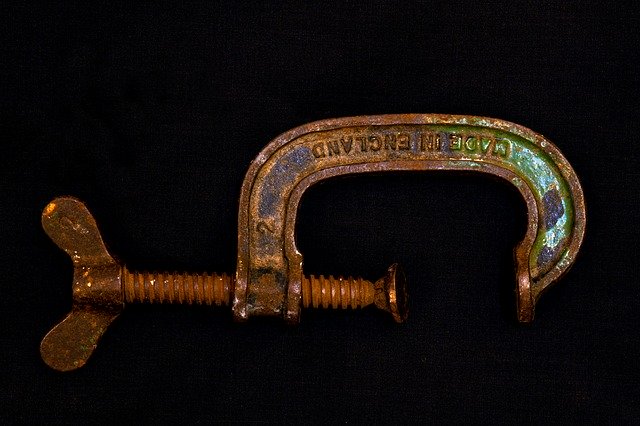Clamp and cramp

|
| A simple cast iron G-cramp (or C-cramp). |
Contents |
[edit] Introduction
A ‘clamp’ (sometimes called a ‘cramp’) is a tool (often made of cast metal) which applies a force to hold two or more objects tightly together. This may be for a temporary period after which the parts will be separated, or they will hold together without the aid of the clamp (for example if they have been glued or screwed).
The word ‘clamp’ tends to be used in engineering while ‘cramp’ tends to be used in woodworking, although to a large extent, the two terms are interchangeable.
In woodworking, a cramp may be used to hold two or more pieces of wood together for as long as it takes for an adhesive to set. Cramps can also be used to hold together assemblies temporarily (before any adhesive is applied) to see how they will fit together. They can also be used to hold small assemblies together while they are being worked on.
Structural Fixings for Ductwork Systems BG 10/2010, By Glenn Hawkins, Published by BSRIA in 2010, states: ‘Clamping occurs when forces are applied to opposing faces of a base material. In the case of a beam clamp, this creates friction and sometimes keying between the jaws or set screw of its clamp and the structural member being sandwiched. This is the operating principle of dovetail wedges used in re-entrant channels and T-head bolts used in cast-in channel systems. Tightening of the clamps to the correct torque is crucial to correct performance of these devices, as is the correct orientation of the clamps, wedges and T-head bolts.’
[edit] G- or C-Cramp
Formed in the shape of a ‘G’ (sometimes referred to as a ‘C’) these metal cramps have a screw mechanism that can be adjusted until the items in question are held tightly. The screw is turned until the object is gripped tightly between the cramp’s adjustable shoe and the cast-metal frame.
[edit] Sash cramps
These are used to clamp together large frames, for example, window frames or drawers. They comprise long metal bars with a screw-adjustable grip at one end; the other end comprises a free-moving jaw that can be adjusted to points at predetermined intervals, usually by inserting pegs into pre-drilled holes. Once the object is in position and the peg inserted into the most suitable hole, the screw end can be adjusted to grip the item firmly.
[edit] Vehicle (or car) clamp
In another application, a clamp is attached to one wheel of a vehicle in order to immobilise it, for example, until a fine is paid to the satisfaction of a parking authority. In this case, the clamp is to prevent mobility rather than to force two objects together.
[edit] Brick clamp
Short Guide: Traditional Scottish Brickwork, published, on 1 March 2014 by Historic Environment Scotland, defines clamp as: ‘A fairly crude but effective method of firing bricks in large numbers, a clamp is formed by interspersing unfired bricks and fuel.’
[edit] Bar clamps
These are versatile clamps with adjustable jaws that can be tightened or loosened to fit different sized materials. They are used for a wide range of tasks, including gluing, cutting, and clamping.
[edit] Pipe clamps
Pipe clamps are designed to clamp around pipes or other cylindrical objects. They are used for securing pipes and tubes in place during construction or maintenance work.
[edit] Spring clamps
Spring clamps use a spring-loaded mechanism to clamp materials together. They are commonly used for clamping light-duty materials such as fabrics, papers, and cardboard.
[edit] Corner clamps
Corner clamps are used for clamping two pieces of wood or other materials together at a 90-degree angle. They are often used in woodworking and cabinet making to ensure precise cuts and joints.
[edit] Bessey clamps
Bessey clamps are heavy-duty clamps that use a screw mechanism to apply pressure to clamp materials together. They are commonly used in metalworking, welding, and other industrial applications.
[edit] Related articles on Designing Buildings
Featured articles and news
ECA progress on Welsh Recharging Electrical Skills Charter
Working hard to make progress on the ‘asks’ of the Recharging Electrical Skills Charter at the Senedd in Wales.
A brief history from 1890s to 2020s.
CIOB and CORBON combine forces
To elevate professional standards in Nigeria’s construction industry.
Amendment to the GB Energy Bill welcomed by ECA
Move prevents nationally-owned energy company from investing in solar panels produced by modern slavery.
Gregor Harvie argues that AI is state-sanctioned theft of IP.
Heat pumps, vehicle chargers and heating appliances must be sold with smart functionality.
Experimental AI housing target help for councils
Experimental AI could help councils meet housing targets by digitising records.
New-style degrees set for reformed ARB accreditation
Following the ARB Tomorrow's Architects competency outcomes for Architects.
BSRIA Occupant Wellbeing survey BOW
Occupant satisfaction and wellbeing tool inc. physical environment, indoor facilities, functionality and accessibility.
Preserving, waterproofing and decorating buildings.
Many resources for visitors aswell as new features for members.
Using technology to empower communities
The Community data platform; capturing the DNA of a place and fostering participation, for better design.
Heat pump and wind turbine sound calculations for PDRs
MCS publish updated sound calculation standards for permitted development installations.
Homes England creates largest housing-led site in the North
Successful, 34 hectare land acquisition with the residential allocation now completed.
Scottish apprenticeship training proposals
General support although better accountability and transparency is sought.
The history of building regulations
A story of belated action in response to crisis.
Moisture, fire safety and emerging trends in living walls
How wet is your wall?
Current policy explained and newly published consultation by the UK and Welsh Governments.
British architecture 1919–39. Book review.
Conservation of listed prefabs in Moseley.
Energy industry calls for urgent reform.



























